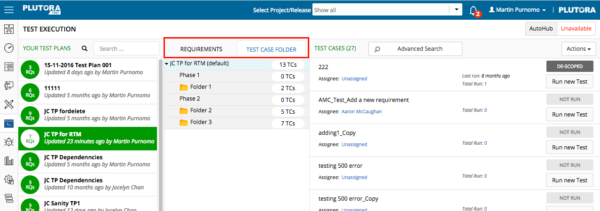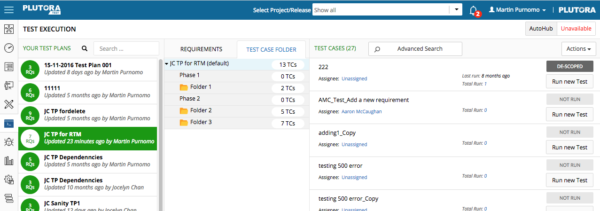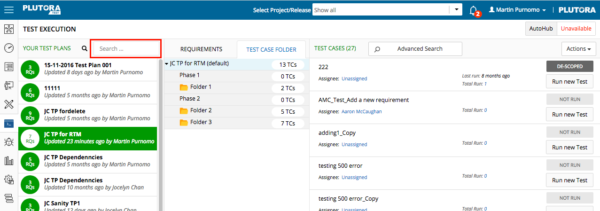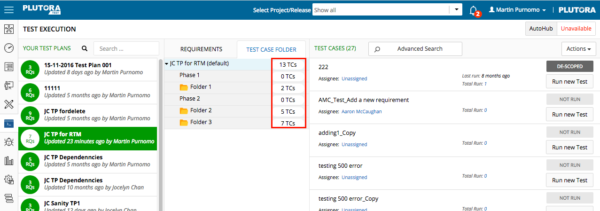The Test Execution page allows users to execute the Test Cases they created in Test Designer. For Manual Test Cases, see Execute A Manual Test Case.
AutoHub must be installed and available or automated Test Cases will have their Run New Test buttons grayed out. See how to install AutoHub.
1. Find the Test Case in Test Execution
To find the Test Case:
- Click Test Execution.

- Search for a Test Plan that contains the Test Case:
Test Execution only displays Active Test Plans. - Click to select a Test Plan.

- Locate the Test Case in the Test Plan:
Test Cases can now be manually sorted in Test Designer. See Manage Test Case Folders.

- Click the Requirements tab and selecting a Requirement.
Or: - Click the Test Case Folder tab and select a folder:
- All new Test Plans now have a default Test Case folder. For example, AMC_TEST PLAN 1 (default) in the screenshot below. When users add Requirements with associated Test Cases into a Test Plan, those Test Cases will be added to the default Test Case folder.
- The Test Case Folder now contains the phases from the Test Plan. For example, UAT above. By default the phases are empty and users must add folders by clicking the new folder button.

- Quick or Advanced Search for a Test Case: Click Advanced Search. See Quick Search and Advanced Search for more information.
- Automated Test Cases have a checkbox and a Selenium icon.

- Click the Requirements tab and selecting a Requirement.
2. Execute an Automated Test Case
AutoHub must be installed and available or automated Test Cases will have their Run New Test buttons grayed out. See how to install AutoHub.
To execute automated Test Cases:
- To run:
- A single automated Test Case:
- Two or more automated Test Cases simultaneously:
- Click to select the automated Test Cases’ checkboxes.

- Select one of the following from the Action drop-down menu:

- Run AlI: To run all the automated Test Cases listed in the Test Case Folder or Requirement.
- Run Selected: To run on the automated Test Cases with selected checkboxes.
During Selenium Integration set up, you can specify how many Test Cases will be run simultaneously. If more than that number are run, they will be queued.
- Click to select the automated Test Cases’ checkboxes.
- The test or tests will run:
- The Run New Test button will change to Sending Request.
- The test or tests will either:
- When the test or tests end:
- The status will change to Failed or Passed.
- The Run New Test button will reappear.
- Manage Comments:
To manage comments, users need the Comments View, Comments Create, and Comments Update user permissions.- Click the Overview tab.
- Add a comment by typing your comment in the Your comment… field and clicking Send.
- Click Edit to edit your comment.
- Click Reply to reply to a comment.
- To tag a User, so that your tagged comment appears in their Comment Stream:
- To view test run log files:








